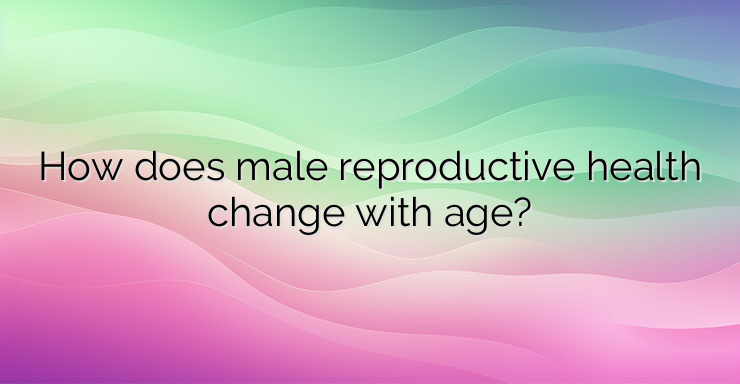Advanced age for conception in women is defined as the age of over 35 years, after which there is a significantly increased risk of unsuccessful attempts to conceive. However, for men this age threshold is not so clearly defined. For men, studies usually define it as between 35 and 50 years of age. A meta-analysis of 90 studies involving 93,839 participants has shown that with age there is a decline in seminal fluid volume, a decrease in total sperm count, sperm motility and morphology, along with an increase in DNA fragmentation. Despite the decrease in the volume of seminal fluid, the concentration of spermatozoa in it remains unchanged with advancing age. The analysis of the quantitative and qualitative characteristics of seminal fluid in healthy men in a wide age range – between 22 and 80 years has shown that the volume of seminal fluid and sperm motility decrease gradually and continuously with age without a specific age threshold. However, a retrospective study involving 5,081 men aged between 16 and 72.3 years showed the following age-specific changes: Decrease in total sperm count and total motile sperm count in seminal fluid after 34 years; Decrease in the concentration of spermatozoa and the fraction of spermatozoa with normal morphology – after 40 years; Decrease in sperm motility – after 43 years; Reduction in the volume of seminal fluid during ejaculation – after 45 years; Change in the proportion of sperm that carry X or Y chromosomes in the seminal fluid – after 55 years. These findings suggest that, regardless of the mother’s age, the likelihood of becoming pregnant after intercourse decreases when the father is over 34 years of age. The exact mechanisms underlying the age-related decline in male fertility are not fully understood. Changes in semen quality are due to the natural physiological changes in reproductive health that occur with age. They are related to the reduced capacity for cell and tissue repair in the presence of damage caused by exposure to toxic substances or diseases. The cumulative effect of exposure to external harmful factors such as smoking or infections also has an influence. As men age, testicular function and metabolism are impaired as the testes undergo age-related morphological changes such as a decrease in the number of germ cells and a decrease in the number of Leydig and Sertoli cells. In addition, structural changes are also observed, including narrowing of the seminiferous tubules. Serum concentrations of free and total testosterone steadily decline as men age, leading to primary hypogonadism. Regulation of the hypothalamic-pituitary-gonadal axis also changes naturally with advancing age in men.Accumulation of free radicals in germ cells in the male reproductive system during aging processes leads to oxidative stress and DNA damage of spermatozoa. Programmed cell death processes also increase in the testis with advancing age. These age-related changes lead to a deterioration in the quality and quantity of seminal fluid. The increase in sperm DNA fragmentation caused by the advancing age of the father adversely affects the success rate of the results of assisted reproduction procedures, as well as the early development of the embryo. Studies have shown a 26% lower chance of a live birth for every 5-year increase in the father’s age. In couples who underwent assisted reproduction procedures, the rate of successful implantation of the fertilized egg and successful pregnancy decreased as the father’s age increased when the mother’s age was between 30-34 years. Regardless of maternal age, advanced paternal age is associated with an increased rate of miscarriage and a lower rate of successful pregnancy when attempting natural fertilization or through assisted reproduction methods. The association between advanced paternal age and the risk of miscarriage suggests that DNA mutations that occur over time are unfavorable for the efficient development of the embryo. Aging processes in the father cause genetic and epigenetic changes in sperm, which can be passed on to the offspring and cause serious complications and diseases. Therefore, couples should be counseled with equal emphasis on the importance of both maternal and paternal advanced age as a potential risk factor for adverse outcomes of assisted reproduction and the occurrence of complications during pregnancy or subsequently for the offspring. References: https://www.ncbi.nlm.nih.gov/pmc/articles/PMC9957550/when the mother’s age is between 30-34 years. Regardless of maternal age, advanced paternal age is associated with an increased rate of miscarriage and a lower rate of successful pregnancy when attempting natural fertilization or through assisted reproduction methods. The association between advanced paternal age and the risk of miscarriage suggests that DNA mutations that occur over time are unfavorable for the efficient development of the embryo. Aging processes in the father cause genetic and epigenetic changes in sperm, which can be passed on to the offspring and cause serious complications and diseases. Therefore, couples should be counseled with equal emphasis on the importance of advanced age in both the mother and the father as a potential risk factor for adverse outcomes of assisted reproduction and the occurrence of complications during pregnancy or subsequently for the offspring. References: https://www.ncbi.nlm.nih.gov/pmc/articles/PMC9957550/when the mother’s age is between 30-34 years. Regardless of maternal age, advanced paternal age is associated with an increased rate of miscarriage and a lower rate of successful pregnancy when attempting natural fertilization or through assisted reproduction methods. The association between advanced paternal age and the risk of miscarriage suggests that DNA mutations that occur over time are unfavorable to the efficient development of the embryo. Aging processes in the father cause genetic and epigenetic changes in sperm, which can be passed on to the offspring and cause serious complications and diseases. Therefore, couples should be counseled with equal emphasis on the importance of both maternal and paternal advanced age as a potential risk factor for adverse outcomes of assisted reproduction and the occurrence of complications during pregnancy or subsequently for the offspring. References: https://www.ncbi.nlm.nih.gov/pmc/articles/PMC9957550/


Leave a Reply